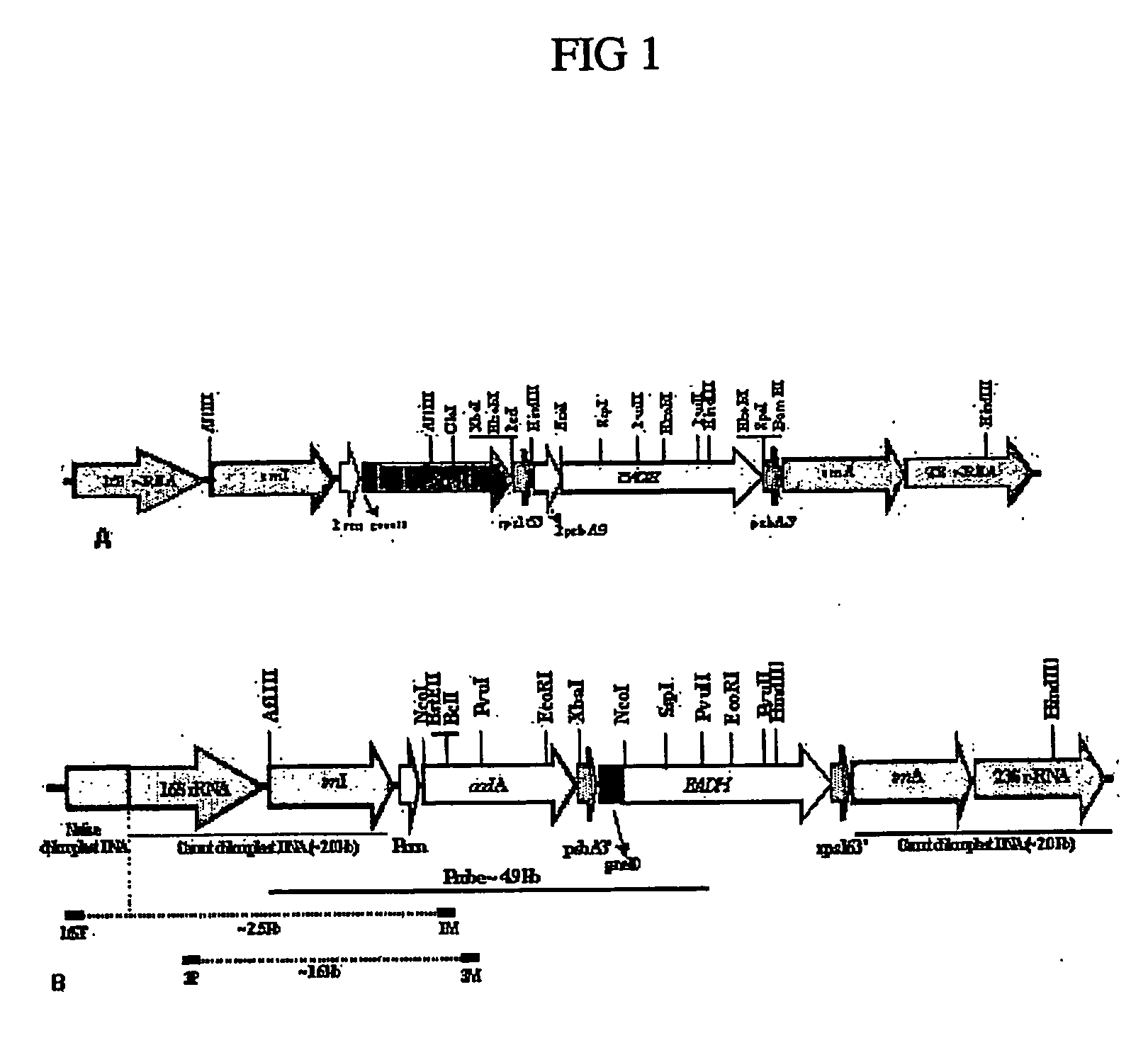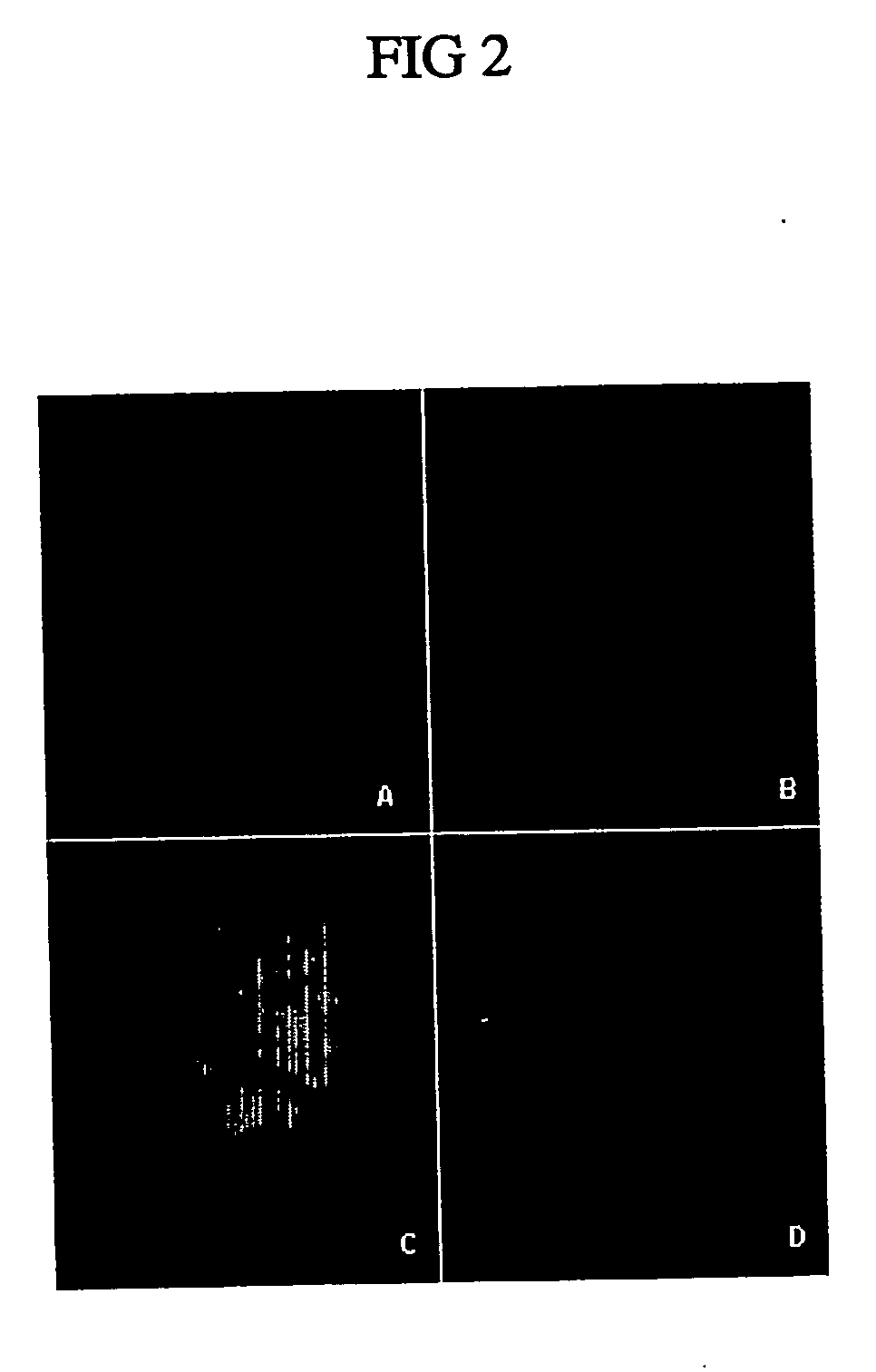Plastid genetic engineering via somatic embryogenesis
a technology of somatic embryogenesis and plastids, applied in the field of plant plastid genetic engineering, can solve the problems of inability to achieve stable integration or homoplasmy in oilseed rape, lack of the benefit of subsequent selection rounds, and inability to achieve stable integration or homoplasmy
- Summary
- Abstract
- Description
- Claims
- Application Information
AI Technical Summary
Benefits of technology
Problems solved by technology
Method used
Image
Examples
example 1
ILLUSTRATIVE EXAMPLE 1
Somatic Embryogenesis Via Carrot Transformation
[0317] Homoplasmic transgenic carrot plants exhibiting high levels of salt tolerance (up to 500 mM NaCl) were rapidly regenerated from carrot cell cultures, via somatic embryogenesis. Carrot chloroplast genome is strictly maternally inherited and plants do not produce seeds in the first year, offering complete containment of transgene flow. Carrot cells multiply rapidly and large biomass is produced using bioreactors; somatic embryos are derived from single cells; viable for long duration on culture medium, encapsulated embryos are used as synthetic seeds for cryopreservation and controlled germination; these features provide an ideal production system for plant made pharmaceutical proteins and their oral delivery. BADH expressing cells offer a visual selection by their green color, distinguishing them from untransformed yellow cells. A useful trait has been engineered via the chloroplast genome for the first time...
example 2
ILLUSTRATIVE EXAMPLE 2
Cotton Transformation
[0359] Material and Methods
[0360] Plant material and transformation: Delinted cotton (Gossypium hirsutum L. cv. Coker310FR) seeds were sterilized by dipping in 70% ethanol for 2 minutes followed an 8 minutes treatment with sodium hypochlorite solution containing approximately 4% available chlorine and then by treatment with 0.1% mercuric chloride solution (w / v) for 5 minutes. After surface sterilization and four to five washes with sterile water, seeds were kept in sterile water for 4-5 hours for softening the seed coat which was completely removed before the seeds were placed on 1 / 2 MSB medium containing half strength MS salts (Murashige and Skoog, 1962) and B5 vitamins (Gamborg et al 1968) with 1.5% sucrose. Hypocotyl explants (4-6 mm long) of 5 day old seedlings were placed vertically on MST1 medium (containing MS salts, B5 vitamins, 0.1 mg / l 2,4-D, 0.5 mg / l kinetin and 3% glucose) for the induction of callus. Uniformly distributed pro...
example 3
ILLUSTRATIVE EXAMPLE 3
Expression Cassette Construction
[0361] Materials and Methods:
[0362] Amplification and cloning of flanking sequences: DNA fragment representing flanking sequences were amplified from plant genomic DNA that was isolated from the leaves using Qiagen plant extraction kit following manufacturer's protocol. The flanking sequence fragment was amplified with the primers, ADLF-5′ gtgtcagtgtcggcccagcagag 3′ and ADLR-5′ aacaggggtcaaggtcggccag 3′ using Platinum Pfx DNA polymerase (Invitrogen Inc.). The amplified fragment represents the 16S / trnI-trnA / 23S region of the chloroplast genome and is approximately 4.2 kb in size. The PCR amplified DNA fragment was treated with T4 polynucleotide kinase (Promega) and cloned into PvuII digested pBluescript II KS dephosphorylated with Shrimp Alakaline phosphatase (Promega). The kinase and dephosphorylation reactions were performed as per the manufacturer's instructions. The clone harboring carrot specific flanking region was designa...
PUM
| Property | Measurement | Unit |
|---|---|---|
| temperature | aaaaa | aaaaa |
| diameter | aaaaa | aaaaa |
| volume | aaaaa | aaaaa |
Abstract
Description
Claims
Application Information
 Login to View More
Login to View More - R&D
- Intellectual Property
- Life Sciences
- Materials
- Tech Scout
- Unparalleled Data Quality
- Higher Quality Content
- 60% Fewer Hallucinations
Browse by: Latest US Patents, China's latest patents, Technical Efficacy Thesaurus, Application Domain, Technology Topic, Popular Technical Reports.
© 2025 PatSnap. All rights reserved.Legal|Privacy policy|Modern Slavery Act Transparency Statement|Sitemap|About US| Contact US: help@patsnap.com



